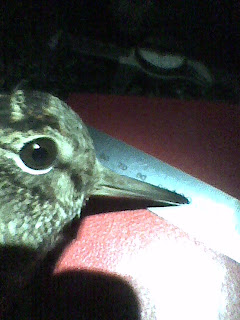Last night Vince and I checked the last 18 Dipper roosts in our Shropshire/Mid Wales Dipper RAS study area and caught/identified another 24 birds including 8 more new ones. Since mid September we have checked over 150 past or present roost sites and caught/identified a total of 152 Dippers comprising 61 new birds and 91 retraps/controls (plus we missed about 25!). The age/sex breakdown of the 152 was 93 adult (49 males, 44 females) and 59 first winter (33 males, 26 females).
A brown-bellied Dipper if ever I saw one!
During the summer we ringed a total of 330 pulli and just 17 (9 males, 8 females) of these were re-trapped. This is a bit lower than would be expected and almost certainly results from the exceptional summer floods that occurred just after many of the birds had fledged. Adult survival seems to have been fairly good though and of 166 adult/juvs colour-ringed at these same sites between April 2011 and May 2012 a minimum of 60 were still present and 54 were retrapped. There are bound to be a fair few others too using unknown natural roosts or that have moved out of the area checked. Apart from revisiting a few of the sites where we've missed birds the next time most of them will be checked is when they start nesting in February. With such a high number now colour-ringed it will be very interesting to see who turns up to breed and where!
The longest movement of a 2012 pulli so far is 32km.

Just how many ringers does it take to ring a Dipper anyway? One to hold the bird, one to apply the colour-rings, one to take the photos and one to take the p***!
Next year's Dipper monitoring is being sponsored by Petzl and BirdWatch Ireland
(oh yes and Spec-Savers!!)
Many thanks to Vince, Lloyd, Jane, Andre, Dave Smith, Gareth Richardson, Brendan Sheils, Simon Holloway, Sarah Cookson, Amy and Hannah for your assistance and company on some late and very wet nights.
Caught 7 more Golden Plovers on the way home too!







-8.jpg)












.jpg)
.jpg)



























